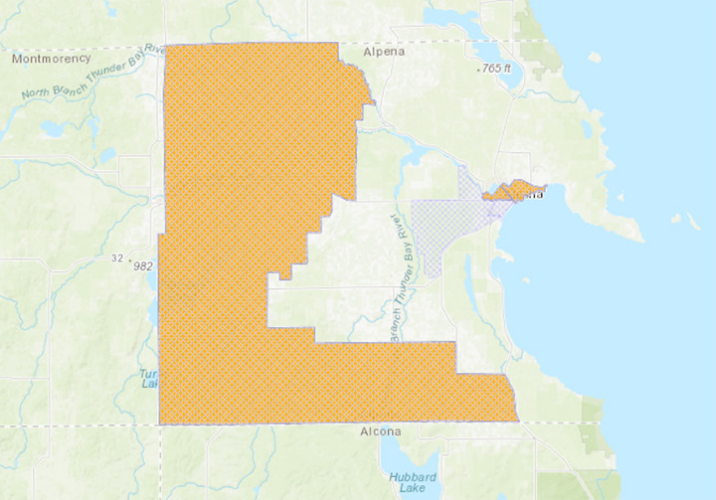Image courtesy of the USDA Economic Research Service. This map shows the Food Access Study Map, which shows past and present food deserts in Alpena County. The orange areas are current food deserts in 2023. The shaded blue areas show the same data from 2015, meaning that food deserts in that part of the county are now eliminated.
ALPENA — As of 2022, more than 1.4 million people in Michigan suffer from food insecurity, according to Feeding America’s “Map the Meal Gap.”
The state’s food insecurity rate averages 14.2 percent, higher than many counties in northeast Michigan.
Counties in the region average an insecurity rating of 17% to 20%, with Otsego County having the lowest and Montmorency County having the highest.
Alpena County ranks on the lower end of the scale at about 18 percent, but more than 5,000 people in the county still face food insecurity.
Many factors influence food insecurity, including poverty and distance to a supermarket.

Image courtesy of Feeding America This image shows a food insecurity map for Michigan, showing food insecurity rates across Michigan counties: Most of the state is between 13% and 26% food insecure, with northeast Michigan trending between 17% and 20%, according to the data.
The latter is calculated by the U.S. Department of Agriculture through its Food Access Research Atlas, which shows areas that suffer from low income and poor access to grocery stores. This data is used to determine food deserts across the country, and while Alpena has seen some food deserts shrink over the past nine years, parts of the county are still considered food deserts.
“Since 2013, the Economic Research Service has used the term ‘low-income/low-access’ to refer to areas with limited access to healthy foods,” Alana Lord, an agricultural economist at the USDA, said in an email.
Lord was one of the people who helped create the atlas.
Lord wrote that while the two categories — low income and poor access to grocery stores — are measured separately, they can overlap.
Alpena County is another example.
She explained that for an area to be considered low-access, at least 500 people must be more than a half-mile (in urban areas) or 10 miles (in rural areas) from a large grocery store. The one-mile distance in urban areas takes into account low accessibility by vehicle, which is included in the calculation.
This data coincides with one of Alpena’s current food pantries, which is run through the Salvation Army Church.
Maj. Preza Morrison, a corps officer and pastor at the Salvation Army Church in Alpena, said while the food pantry is open to the public, most of the recipients come from the north side of town, which is a food desert.
“We probably have close to 25 people that come through our food pantry a week,” she said, “depending on what time of the week or what time of the month it is and whether they’re still receiving food stamps or have other financial assistance.”
Morrison said the food pantry offers residents a variety of options, including canned goods, cereals, meats, fruits and vegetables, and also provides more food options for children during the summer to make up for school being out.
“The hardest part is seeing people having to come to food pantries,” she said. “We hope people can stabilize themselves, but in the current economic situation, some of the services the government provides can’t necessarily meet the needs of our people.”
Morrison said she has seen cases where residents have had emergencies like illness or car breakdowns that affect their income, leading to residents cutting back on food purchases, but she said they know they can rely on food pantries like hers.
“I’m glad that we have an agency, and not just one in town, that’s feeding people because people need food to function and to live,” she said. “The role is to think clearly so that they can work better at work, or if they’re in school, to think clearly while they’re in school. If they’re eating healthy, they even have to go to the doctor or dentist less.”
This week, Alpena opened a new ALDI grocery store on M-32, known for offering fresh produce and meats at low prices.
Morrison said he believes there are pros and cons to the store opening for people currently struggling with food insecurity, as most people who visit food pantries do so on foot or by bike.
“It will be harder for them, but prices will go down,” she said. “They may be able to buy vegetables and fruits that they normally can’t buy. There will be pros and cons, but I hope the pros outweigh the cons.”
This story was produced by the Michigan News Group Internship Program, a collaboration between WCMU Public Media and local newspapers in central and northern Michigan, whose mission is to develop the next generation of journalists and combat the growing local news desert.

Image courtesy of the USDA Economic Research Service. This map shows the Food Access Study Map, which shows past and present food deserts in Alpena County. The orange areas are current food deserts in 2023. The shaded blue areas show the same data from 2015, meaning that food deserts in that part of the county are now eliminated.

Image courtesy of Feeding America This image shows a food insecurity map for Michigan, showing food insecurity rates across Michigan counties: Most of the state is between 13% and 26% food insecure, with northeast Michigan trending between 17% and 20%, according to the data.
Get the latest news from the day and more delivered to your inbox
The History Channel television show “American Pickers” will return to Michigan in August, media outlets are reporting.
The sixth annual Hillman Boys Basketball Camp will be held June 27 and 28 from 9 a.m. to noon at 26042 Hillman High School.
ALPENA, NE LOWER PENINSULA: Walleye were still being caught in good numbers in Thunder Bay for anglers…


